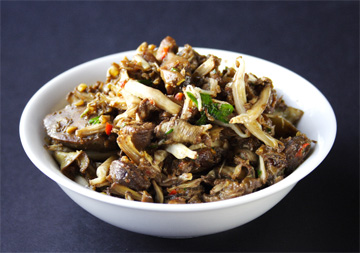One man’s Poison is another man’s Feast
Hi Everyone,
“Try and don’t poison the people.” This remark stopped me, my knife suspended over the banana blossom I was frantically chopping and tossing into the bowl of waiting yogurt to prevent oxidization (discolouration). Suddenly I was overcome with fear and self-doubt. Part of me wanted to continue, part of me wanted to stop. What if my friend was right? What if I poisoned myself and my tasters? What if I poisoned my readers by suggesting that they try cooking and eating banana blossom? I flashed back to all the info I had read about how edible the banana blossom is and I recalled the various delicious photographs of cooked banana blossom and realized that one man’s poison is another man’s feast. I screwed up my courage and continued chopping.
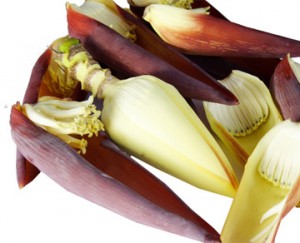
Here in the Caribbean, we love bananas – green or ripe and we boast a wide variety. We admire the miracle of growth as the banana tree bears fruit with its purple, pear-shaped blossom bowed to the ground, making room for rows of bananas. Instinctively we know when to pick the bananas – either to be eaten in their green state in a green-banana salad, boiled or eaten with sautéed salt fish or in an oil-down or to be placed somewhere dark to ripen and become sweet. The leaves are used as plates and a cooking utensil in which we wrap foods to steam, roast or bake. With all these uses, who knew there could be even more? Who knew that the blossom too is edible! Sceptical? Read on.
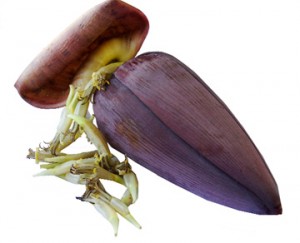
Banana blossom, firm, purple and cone-shaped is eaten widely in Southeast Asia and is a feature of the cuisines of Tamil Nadu, Bengal and Kerala. From the moment I read and saw the banana blossom featured in a stir-fry I was determined to try it. I had no expectations of what it would taste like. I set about asking my friends from afar whom I’d seen wax lyrically about the delights of banana blossom. My friend Sia wrote about the memories of watching her great grandmother chopping the blossoms, “Shruk, shruk, shruk… the rhythmic sound coming from chopping the vegetables on that blade was fascinating to me. Within few minutes she would have finished chopping dozens of Banana Blossoms and take it to the dark, steamy kitchen where magic was created every time she cooked.” I wanted to create my own magic by cooking and tasting this new ingredient for the first time. Armed with two fresh banana blossoms, I set about making two dishes both with the method of a stir-fry/sauté; one recipe was Indonesian and the other Indian.
The Indonesian dish, cooked in the style of tumis (sautéed) required aromatic ingredients such as galangal (I substituted with ginger), bay leaves, onions, hot pepper and garlic to be sautéed. The recipe also called for chicken hearts but I used chicken liver and gizzards instead; these were added to the sautéed aromatics and finally, the chopped banana blossom which cooks up very quickly.
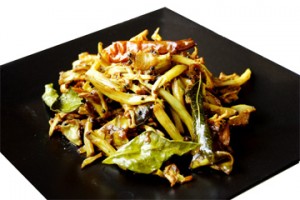
The second dish, I made, playa (a type of sauté/fry), required a lot more ingredients: tamarind, jaggery, turmeric, onion and grated coconut along with hot pepper. It was also important to temper the dish by frying some mustard seeds, curry leaves, asafoetida (hing) and urad dal in oil, much like chunkaying dhal. The tadka (temper) ingredients were added to hot oil in stages and finally the banana blossom. When I’d finished cooking both dishes along with some rice, my tasters and I sat down to evaluate the dishes and the banana blossom ingredient itself.
We found the texture of the banana blossom to be two-fold: crunchy, from the young inner purple petals and the heart – white creamy inner part. The other texture from the young white flowers we found to be soft and cloth-like almost like katahar (breadnut). When you put the banana blossom into your mouth your taste buds are caught up with the aromatics and other flavourful ingredients but as you continue to chew, the notes of bitterness come through clearly, especially at the back of the throat. The bitterness at the back of the throat is almost like an echo, it lingers but not for too long. The bitterness made me think of karaila (bitter melon), only that the bitterness of karaila hits you immediately.
Each dish had its own distraction that kept us eating. For the Indonesian stir-fry it was the liver and gizzards and for the Indian Palya, it was the complexity of flavour offered by the tamarind, jaggery, hing and mustard seeds. We all agreed that both dishes needed to be eaten with a plain robust starch such as the rice we used, that way, the intensity of the texture and bitterness are diluted. While we all agreed that both dishes tasted good, no one was enthusiastically taking seconds. The bottom line for us is that it is an acquired taste. It is one of those things that you’d either love or hate. I think that I can grow to like it. Eaten with rice and some achar or even a little dhal, it is bound to go down well.
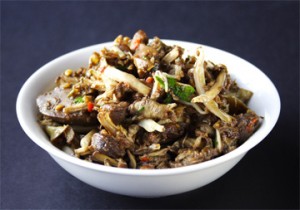
It is clear from my research that banana blossom has been in use for ages and many believe that it is a natural cure for some ailments such as menstrual cramps and excess bleeding (I know, I know, it’s a food column). Apparently, long ago, it used to be given to pregnant women as a lactating agent. Today, however, banana blossoms are used for the pure pleasure of their unique taste.
I believe that it is good to try new ingredients and explore other cuisines. It is also exciting to discover something that you see all the time and marvel at, only to discover that it is edible! If you’d like to try cooking banana blossoms yourself here’s what you need to know. First, it is important to ensure that your hands are well oiled when handling the banana blossom as it stains easily (I used latex gloves). Be sure to oil your knife as well and protect your work surface by covering it with paper or something that can be easily discarded. Secondly, have a bowl ready with some diluted buttermilk or yogurt or with lime or lemon juice in water. As soon as you chop the blossoms, drop them into the solution to prevent discolouration. With your hands and knife oiled, your work surface protected and the bowl with buttermilk, yogurt, lime or lemon juice standing by, you are ready to peel and chop your banana blossom.
Start by removing the hard, dry outer petals until you get to the soft tender ones. Or you can remove those too until you get to the heart of the banana blossom where you will only see cream coloured petals. Beneath each petal you remove, you will notice a row of slender, delicate flowers, those too are edible. For the mature flowers, you will need to remove the black stalk found in the middle of the flower but for the young florets you do not have to remove the black stalk. When you are ready to cook your banana blossom, drain from the soaking solution, rinse and drain again, shaking off any excess water. Cook as prescribed in the recipe. You can email me for one or both of the recipes of the dishes mentioned in this column if you’d like to give banana blossom a try. I’ve seen it used in salads also so you have some options.
Cynthia
tasteslikehome@gmail.com
www.tasteslikehome.org

